
Arabis, or rockcress, is a genus of flowering plants, within the family Brassicaceae.
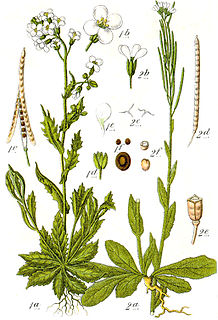
Arabis hirsuta, known as hairy rock-cress, is a flowering plant of the genus Arabis in the family Brassicaceae. In previous North American works, this species has been broadly defined to include plants native to Europe, Asia, and the northern half of North America, but is now more often restricted to a narrower subgroup restricted to Europe.
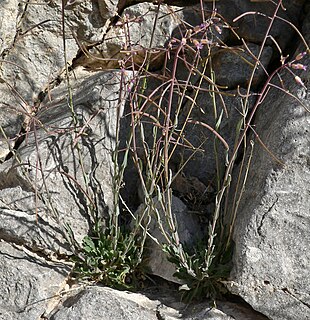
Boechera perennans is a species of rockcress known as perennial rockcress. It is native to the southwestern United States and northern Mexico. This rockcress forms several erect stems reaching past half a meter in height at maximum. The basal leaves may be several centimeters long and are hairy and often toothed, while the scattered upper leaves are smaller. Toward the top of the stem are small widely spaced purple or pink-purple flowers on long, thin stalks. These give way to the fruits, which are siliques: long, very narrow pods up to 6 centimeters long.

Boechera sparsiflora is a species of rockcress known by the common names sicklepod rockcress and elegant rockcress. It is native to western North America from California to Utah to Yukon, where it can be found in a number of habitats. This is a coarsely hairy perennial herb growing one or more thick stems from a caudex. The stem may branch or not and it reaches up to 90 centimeters in maximum height. The leaves vary in shape from linear to arrowhead-like and may or may not have toothed edges. They are usually hairy and up to 8 or 10 centimeters long. The raceme inflorescence bears a number of flowers with spoon-shaped petals about a centimeter long in shades of purple or pink. The fruit is a large, curved silique 6 to 12 centimeters long
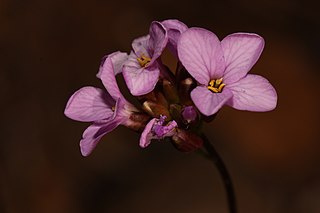
Arabis aculeolata is a species of flowering plant in the mustard family known by the common name Waldo rockcress. It is native to a small range in the mountains of southern Oregon, where it is an uncommon member of the serpentine soils flora. Reports of its occurrence in Del Norte County, California are unconfirmed.
Boechera cobrensis is a species of flowering plant in the mustard family known by the common names Masonic rockcress and sagebrush rockcress. It is native to the western United States from eastern California to Wyoming, where it is found in sandy habitat, especially sagebrush. This is a perennial herb growing several erect, slender stems to heights near half a meter from a branching caudex. The plant forms a narrow clump with a base of narrow, linear, densely hairy leaves up to 5 centimeters long. There are also a few slightly shorter leaves clasping the stems at intervals. The top of each stem is occupied by an inflorescence of small, nodding flowers with dull yellowish sepals and white petals. The flowers give way to fruits which are narrow, straight siliques up to 4 centimeters long containing winged seeds.
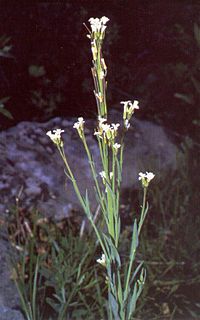
Boechera stricta is a species of flowering plant in the mustard family known by the common name Drummond's rockcress. It is native to much of North America, including most of Canada, and the western and northeastern United States. It can be found in many habitat types, including disturbed areas. It is a biennial or perennial herb growing one or more erect stems from a small caudex. The stems may branch near the top and reach heights anywhere between 30 and 90 centimeters. They are generally not hairy. There is a basal clump of widely lance-shaped leaves about the caudex, each up to 8 centimeters long. There are also widely spaced leaves along the stem. The top of the stem is occupied by a narrow inflorescence of flowers which are usually white, but sometimes light pink. The fruit is a straight, erect silique up to 10 centimeters long containing two rows of winged seeds.

Boechera hoffmannii is a rare species of flowering plant in the family Brassicaceae known by the common name Hoffmann's rockcress. It is endemic to the Channel Islands of California, where it is known from only three or four populations on two of the eight islands. A 2005 report estimated a remaining global population of 244 individual plants. It is a federally listed endangered species.

Arabis lemmonii is a species of flowering plant in the family Brassicaceae known by the common name Lemmon's rockcress. It is native to western North America from Alaska to California to Colorado, where it grows in a number of rocky habitat types.

Arabis macdonaldiana is a species of flowering plant in the mustard family known by the common name MacDonald's rockcress. It is native to northern California and Oregon, where it grows on newly exposed, barren serpentine soils in openings in temperate coniferous forest habitat. It is a rare and endangered plant known from several sites in California and approximately two occurrences in Oregon, where it is threatened mainly by mining, particularly of nickel, which is one of several metals plentiful in the serpentine. On September 29, 1978, this was the second plant to be federally listed as an endangered species.

Boechera breweri is a species of flowering plant in the family Brassicaceae known by the common name Brewer's rockcress.
Boechera constancei is a species of flowering plant in the mustard family known by the common name Constance's rockcress. It is endemic to California, where it is known only from the northern Sierra Nevada of Plumas and Sierra Counties. It is a member of the serpentine soils flora. This is a perennial herb growing from a branching, woody caudex. It produces one or more erect, hairless stems to maximum heights between 15 and 30 centimeters. The caudex is surrounded by a dense basal rosette of stiff, blue-green, lance-shaped leaves up to 3 centimeters long. There may be a few smaller leaves along the stem. The inflorescence produces 5 to 10 white mustardlike flowers with protruding stamens. The fruit is a hanging green silique 4 or 5 centimeters long which contains round, winged seeds.
Boechera dispar is a species of flowering plant in the family Brassicaceae known by the common name pinyon rockcress. It is native to eastern California and western Nevada, where it grows in rocky areas in desert and mountain habitat. This is a perennial herb growing from a branching caudex. It produces several erect stems reaching 10 to 25 centimeters tall. The leaves are mostly located about the caudex. They are linear to lance-shaped, coated in white hairs, and one or two centimeters long. The flowers have purple petals. The fruit is a long, narrow, hairless silique up to 7 centimeters long containing round, winged seeds.

Sibara filifolia, the Santa Cruz Island winged rockcress or Santa Cruz Island rockcress, is a rare species of flowering plant in the family Brassicaceae. It is endemic to the Channel Islands of California, where it is now known from a few occurrences on San Clemente Island and one population on Catalina Island.
Sibara virginica is a species of flowering plant in the family Brassicaceae known by the common name Virginia winged rockcress. It is native to North America, where it can be found throughout the southeastern quadrant of the United States and in California and Baja California in the west. It grows in many types of habitat, including disturbed areas. It is an annual or biennial herb producing a basal rosette of leaves with comblike blades so deeply divided into many lobes that they may appear to have leaflets. It bolts one or more erect stems up to 30 centimeters tall. The flowers each have four spoon-shaped white petals a few millimeters long and purplish sepals. The fruit is a flattened, elongated silique up to 2.5 centimeters long containing tiny seeds.
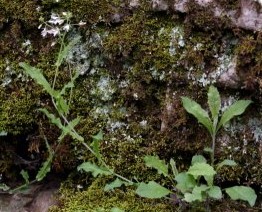
Boechera perstellata is a rare species of flowering plant in the mustard family known by the common names Braun's rockcress and Nevada rockcress. It is native to Kentucky and Tennessee, where it is known from perhaps 25 total populations. Most of the occurrences have few individuals, and all are deteriorating in quality. The plant grows in shady forest habitat on limestone substrates, usually near streams or rivers. This is a federally listed endangered species of the United States.

Arabis serotina is a rare species of flowering plant in the mustard family known by the common name shale barren rockcress. It is native to eastern West Virginia and western Virginia in and around the Shenandoah Valley, where it is known from fewer than 60 populations. It is endemic to the shale barrens, a type of habitat characterized by steep slopes of bare shale, an exposed, rocky habitat type that is subject to very dry and hot conditions. Shale barrens host a number of endemics, such as Allium oxyphilum and Taenidia montana, and this rockcress is among the rarest. It is a federally listed endangered species.
Boechera falcatoria is a rare species of flowering plant in the family Brassicaceae known by the common name Grouse Creek rockcress. It is endemic to Utah in the United States, where it is known only from Box Elder County. It has been reported from neighboring Nevada, but these reports are likely based on misidentifications.
Boechera ophira is a rare species of flowering plant in the mustard family known by the common name Ophir Pass rockcress, or Ophir rockcress. It is endemic to Nevada in the United States, where it is known from Nye and Lander Counties. It grows on the crest of the Toiyabe Range.
Boechera fecunda is a species of flowering plant in the mustard family known by the common names Mt. Sapphire rockcress and bitterroot rockcress. It is endemic to Montana in the United States, where there are twenty known occurrences in three counties.














